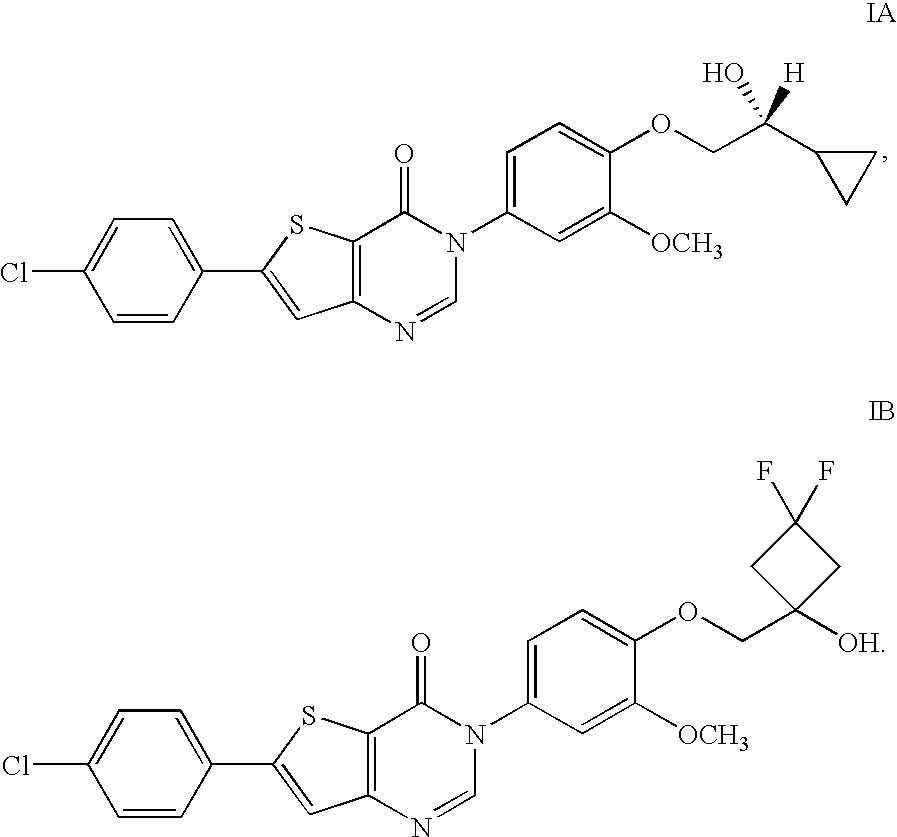Hydroxy substituted thieno pyrimidinones as melanin concentrating hormone receptor-1 antagonists
a technology of melanin concentrating hormone and hydroxy substituted thieno pyrimidinone, which is applied in the direction of group 3/13 element organic compounds, drug compositions, metabolic disorders, etc., can solve the problems of increased food intake, weight loss, and decreased feeding in diet-induced obese mice, and achieves superior pharmacodynamic, pharmacokinetic and safety profiles
- Summary
- Abstract
- Description
- Claims
- Application Information
AI Technical Summary
Benefits of technology
Problems solved by technology
Method used
Image
Examples
example 1
[0108]
A. 2-Bromo-1-cyclopropylethanone
[0109]
[0110]Following the procedure described by Calverley, M. J. et alt, Tetrahedron Lett., 43:4609 (1987), Br2 (21.72 mL, 422 mmol) was added over 5 min to a solution of 1-cyclopropylethanone (35.44 g, 421 mmol) in MeOH (250 mL) at 0° C. Decolorization occurred as the resulting dark orange solution was stirred at 2O (4×). The combined organic layers were sequentially washed with 1M Na2CO3 (150 ml) and brine (100 ml) before drying over any. MgSO4. After filtration and concentration using a rotary evaporator, the crude product was obtained as colorless oil. Subsequent distillation at 13 mm Hg yielded 40.9 g of 2-bromo-1-cyclopropylethanone as a colorless oil bp 58-62° C. 1H NMR (500 MHz, CDCl3) δ ppm 0.95-1.03 (m, 2H), 1.08-1.15 (m, 2H), 2.13-2.21 (m, 1H), 4.00 (s, 2H).
B. 1-Cyclopropyl-2-(2-methoxy-4-nitrophenoxy)ethanone
[0111]
[0112]An orange suspension of 4-nitroguaiacol potassium salt hydrate (31.7 g, 153 mmol) and 2-bromo-1-cyclopropylethanon...
example 2
6-(4-Chlorophenyl)-3-(4-((3,3-difluoro-1-hydroxycyclobutyl)methoxy)-3-methoxyphenyl)thieno[3,2-d]pyrimidin-4(3H)-one
[0134]
A. 3,3-Difluoro-N,N-dimethylcyclobutanecarboxamide
[0135]
[0136]Oxalyl chloride (21.74 mL, 248 mmol) was added dropwise to a stirred solution of 3,3-difluorocyclobutanecarboxylic acid (26 g, 191 mmol; prepared as described in ref: Elend, D. et al., Syn. Comm., 35:657 (2005)) in CH2Cl2 (500 mL) and DMF (0.5 mL) at 0° C. The reaction mixture was allowed to come to RT and stirred at RT for 1 h prior to being concentrated at RT using a rotary evaporator at ca. 50 mm Hg vacuum. After adding THF (300 μL) to the resulting residue, the stirred solution was cooled 0° C. prior to addition of a 2M solution of Me2NH (478 mL, 955 mmol) in THF. After stirring the reaction mixture at RT for 0.5 h, the mixture was partitioned between ether and 5% aq. Na2CO3. The organic layer was dried over MgSO4 and concentrated in vacuo at RT. After portioning the residue between CH2Cl2 and wate...
examples 3 to 11
[0152]Prodrugs of the Examples 1 and 2 compounds were prepared to improve solubility and exposure. Standard conditions were employed to generate amino acid esters of both alcohols. Preparation of the respective half-esters of dibasic acids such as oxalic, malonic, succinic and glutaric acids are exemplified in Examples 7 and 11. Examples 3 and 8 exemplify preparation of a mono-phosphate ester.
PUM
| Property | Measurement | Unit |
|---|---|---|
| Temperature | aaaaa | aaaaa |
| Temperature | aaaaa | aaaaa |
| Temperature | aaaaa | aaaaa |
Abstract
Description
Claims
Application Information
 Login to View More
Login to View More - R&D
- Intellectual Property
- Life Sciences
- Materials
- Tech Scout
- Unparalleled Data Quality
- Higher Quality Content
- 60% Fewer Hallucinations
Browse by: Latest US Patents, China's latest patents, Technical Efficacy Thesaurus, Application Domain, Technology Topic, Popular Technical Reports.
© 2025 PatSnap. All rights reserved.Legal|Privacy policy|Modern Slavery Act Transparency Statement|Sitemap|About US| Contact US: help@patsnap.com



